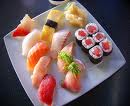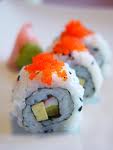 |
|
|
| I chose sushi as my favorite food because I like everything about it. It tastes good it's a little strange to eat andit looks good. So this page is all about my favorite food, sushi. |
|
|
 |
The traditional form of sushi is fermented
fish and rice, preserved with salt in a process that has been traced to
Southeast Asia, where it remains popular today. The term sushi comes from
an archaic grammatical form no longer used in other contexts; literally,
"sushi" means "it's sour",a reflection of its historic fermented roots.
The science behind the fermentation of fish packed in rice is that the vinegar produced from fermenting rice breaks the fish down into amino acids. This results in one of the five basic tastes, called umami in Japanese. The oldest form of sushi in Japan, Narezushi still very closely resembles this process. In Japan, Narezushi evolved into Oshizushi and ultimately Edomae nigirizushi, which is what the world today knows as "sushi." |
|
|
|
| Back to Top |
| Sushi is cooked vinegared rice that is commonly topped with other ingredients, such as fish or other seafood, or put into rolls. Sliced raw fish alone is called sashimi, as distinct from sushi. Sushi that is served rolled inside or around dried and pressed layer sheets of seaweed (or nori) is makizushi. Toppings stuffed into a small pouch of fried tofu is inarizushi. Toppings served scattered over a bowl of sushi rice is called chirashi-zushi. |
 |
|
|
|
| Back to Top |
 |
The original type of sushi, classified
today as nare-sushi, first developed somewhere in Southeast Asia, disseminating
to Japan. Fish was salted and wrapped in fermented rice, a traditional
lacto-fermented rice dish. Nare-sushi was made of this gutted fish stored
in fermented rice for preservation. Nare-sushi was stored for fermentation
for a few months then removed. The fermented rice was discarded and fish
was the only part consumed. This early sushi became a great source of protein.
The Japanese preferred to eat the fish with the rice, called seisei-sushi. During the Muromachi period seisei-sushi was the most popular type of sushi. Seisei-sushi was partly raw fish wrapped in rice, consumed fresh, before it lost its flavor. This new way of consuming fish was no longer a form of preservation but rather a new dish in Japanese cuisine. During the Edo era (the early modern period, 1603 to 1868 in Japan), a third type of sushi was introduced, haya-sushi. Haya-sushi was assembled so that both rice and fish could be consumed at the same time, and the dish became unique to the Japanese culture. It was the first time that rice was not being used for fermentation. Rice was now mixed with vinegar. Fish, vegetables and dried preserved foods would be added. This type of sushi is still very popular today. Each region utilizes local flavors to produce a variety of sushi that has been passed down for many generations. When Tokyo was still being called Edo, at the beginning of the 19th century, mobile food stalls became the dominant food service. During this period nigiri-sushi was introduced. Nigiri-sushi is the most common type of sushi in the modern sushi restaurants. It is an oblong mound of rice with a slice of fish draped over it. After the Great Kanto earthquake in 1923, nigiri-sushi chefs lost their jobs and spread throughout Japan and popularised the dish throughout the country. |
|
|
|
| Back to Top |